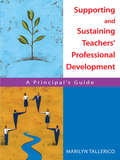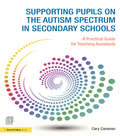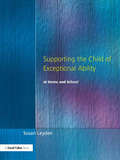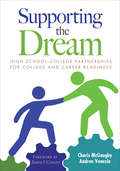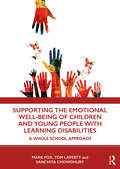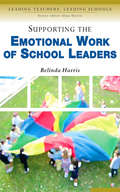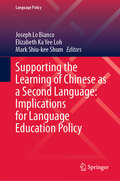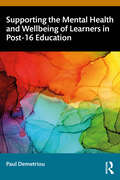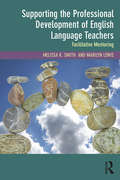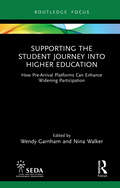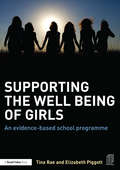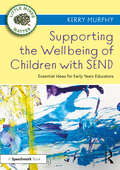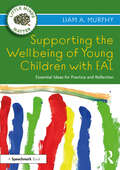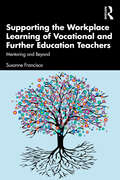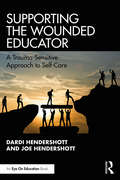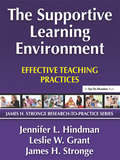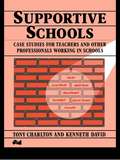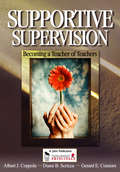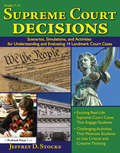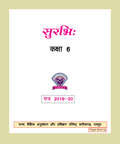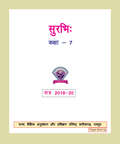- Table View
- List View
Supporting and Sustaining Teachers' Professional Development: A Principal's Guide
by Dr Marilyn TallericoThis text specifically targets busy school principals who want practical suggestions grounded in national NSDC standards for balancing everyday administrative tasks while encouraging teachers' professional growth.
Supporting pupils on the Autism Spectrum in Secondary Schools: A Practical Guide for Teaching Assistants
by Carolyn CanavanWritten to meet the needs of teaching assistants and learning support assistants, this book provides a practical toolkit for supporting students on the autistic spectrum in mainstream secondary schools. The book offers a clear, jargon free explanation of autism spectrum conditions and examines the difficulties arising from these conditions and how they can impact on students’ learning. Addressing issues which arise on a daily basis, it is full of practical advice and strategies for supporting students socially and academically across all areas of the curriculum. Features include: templates to scaffold students’ comprehension and learning in different subject areas forms to help with information collection and evaluation advice on supporting students through examinations examples and case studies to illustrate how the strategies described work in practice Packed with photocopiable resources that can be adapted to suit individual students’ needs, this book is essential reading for teaching assistants that want to help their students’ on the autistic spectrum to reach their full potential.
Supporting the Child of Exceptional Ability at Home and School
by Susan LeydenDrawing on theories of child development and on research in the processes of learning, this book examines the challenges that children, parents and teachers may face at various stages of a child's development. Children whose development is unusual in any way may experience particular challenges in forming relationships and in making good progress in school. If we are to help children of exceptional ability to develop into confident and well-adjusted young people, we need to understand what lies behind many of the common frustrations and problems some of them may experience. This book looks at ways in which supportive learning environments can be created in which children and young people's abilities can be nurtured and encouraged. Ways in which the school curriculum can be extended and enriched to maintain children's interest and enthusiasm in their learning are also explored. This will be of particular interest to parents, teachers and educational psychologists, to teachers in training, and to other professionals who support the work of families and schools.
Supporting the Development of Speech, Language and Communication in the Early Years: Includes Downloadable Assessment Tools, Checklists, Recording Forms, Advice and Information Leaflets and Intervention Strategies
by Jo Williams Diana McQueenSpeech and language impairment can have a huge impact on cognitive development. Identifying what is going wrong and what effective intervention looks like can be daunting. Short of retraining you as a speech and language therapist, this thorough guide will give you everything you need to change that.An essential resource, the book contains a wide variety of online resources, including phonological and sound awareness documents, assessment tools, and recording forms that can be downloaded straight to your device, providing excellent materials and activities to use in the classroom.Written by speech and language therapists and designed exclusively for Early Years practitioners, this book provides a complete overview of how children acquire language and what language impairments look like at this age. You will find both strategic and practical advice on how to manage and encourage the development of speech and language skills. Creating the optimum communication environment for every child in your setting is an important part of what the book offers. Equally, practitioners are supported to be able to recognise the features of specific language difficulties such as Developmental Language Disorder (DLD) and feel confident to intervene when children are struggling.
Supporting the Dream: High School-College Partnerships for College and Career Readiness
by Charis L. McGaughy Andrea VeneziaEducational partnerships for postsecondary readiness – your resource guide is here! High school graduates want to be prepared to succeed in life after high school; for most that includes completing some form of postsecondary education. This thoroughly researched guide to building and sustaining effective, cross-system partnerships between high schools, colleges, and regional and local communities will help educators support students’ college and career readiness. College and career readiness experts, McGaughy and Venezia lead education stakeholders through a step-by-step process that improves postsecondary outcomes for all students. This book stresses the need to build effective working relationships and offers practical, actionable, information and straightforward strategies to help you: Identify needs Leverage existing relationships, programs and resources Build and sustain regional and local partnerships Implement a plan to measure key outcomes and provide comprehensive supports to ensure postsecondary readiness Connect policies and practices across partnerships to benefit student learning Communicate and work across partnerships to support successful student transitions Includes key research findings, real-world examples and reflections, and templates to guide your work to support improved student learning. "As high schools strive to partner with post-secondary institutions to improve their students’ college readiness, they will find the how-to answers here." Dave Daniels, Principal Susquehanna Valley Senior High School "I found the material interesting, engaging, and important. This book provides a solid rationale for partnership, provides a blueprint that is detailed enough to be helpful and loose enough to make clear that there is no one way approach but rather than their partnership must reflect their context." Natalie B. Schonfeld, Director Student Transition Services, University of California, Irvine
Supporting the Dream: High School-College Partnerships for College and Career Readiness
by Charis L. McGaughy Andrea VeneziaEducational partnerships for postsecondary readiness – your resource guide is here! High school graduates want to be prepared to succeed in life after high school; for most that includes completing some form of postsecondary education. This thoroughly researched guide to building and sustaining effective, cross-system partnerships between high schools, colleges, and regional and local communities will help educators support students’ college and career readiness. College and career readiness experts, McGaughy and Venezia lead education stakeholders through a step-by-step process that improves postsecondary outcomes for all students. This book stresses the need to build effective working relationships and offers practical, actionable, information and straightforward strategies to help you: Identify needs Leverage existing relationships, programs and resources Build and sustain regional and local partnerships Implement a plan to measure key outcomes and provide comprehensive supports to ensure postsecondary readiness Connect policies and practices across partnerships to benefit student learning Communicate and work across partnerships to support successful student transitions Includes key research findings, real-world examples and reflections, and templates to guide your work to support improved student learning. "As high schools strive to partner with post-secondary institutions to improve their students’ college readiness, they will find the how-to answers here." Dave Daniels, Principal Susquehanna Valley Senior High School "I found the material interesting, engaging, and important. This book provides a solid rationale for partnership, provides a blueprint that is detailed enough to be helpful and loose enough to make clear that there is no one way approach but rather than their partnership must reflect their context." Natalie B. Schonfeld, Director Student Transition Services, University of California, Irvine
Supporting the Emotional Well-being of Children and Young People with Learning Disabilities: A Whole School Approach
by Mark Fox Tom Laverty Sanchita ChowdhurySupporting the Emotional Well-being of Children and Young People with Learning Disabilities is an essential and practical resource for helping children with severe and complex learning difficulties, their classmates, their teachers and the schools that they attend. The highly adaptable materials, activities and ideas presented in this book will be useful both in the classroom and in staff training to promote understanding of emotional well-being and mental health of all pupils who may need support. Fox, Laverty and Chowdhury cover a range of topics that engage with the school as a whole, inclusive classrooms and the individual student. Their frameworks and practical suggestions aid teachers to support the well-being and mental health of students in a variety of ways, with material tailored for classrooms and the individual student. Supporting the Emotional Well-being of Children and Young People with Learning Disabilities is a comprehensive resource for teachers and management in special needs schools, recognising current government policies and helping teachers to understand and appropriately engage with students as individuals and as classes.
Supporting the Emotional Work of School Leaders (Leading Teachers, Leading Schools Series)
by Ms Belinda HarrisThis practical book deals with the emotional and moral dimensions of school leadership. The author sets out the intra-personal and interpersonal attributes, attitudes and behaviours necessary to develop emotional and moral leadership within the school community. The book provides a range of person-centred strategies for building communities of professionally committed, relationally competent, collaborative individuals.
Supporting the Learning of Chinese as a Second Language: Implications for Language Education Policy (Language Policy #36)
by Joseph Lo Bianco Mark Shiu-kee Shum Elizabeth Ka Yee LohThe research in this volume takes account of the context of policy promoting Chinese as a second language (CSL) in several countries and regions, (Australia, East Asia and South-East Asia), and the wider social context of multilingual and multicultural societies. Furthermore, this book reports results of two research studies which investigated how to develop effective strategies to promote learners’ motivation and the motivational developments of adult learners in real-life settings, helping to overcome gaps in this under-researched area. Findings reported in this book have been scientifically examined and found to be effective in enhancing the learners’ CSL proficiency, increasing their learning motivation, and addressing the need for a diversity of targeted approaches to CSL. Most are applicable across preschool to secondary levels. The theoretical grounding of this research work represents a new direction for research in teaching Chinese as a second language.
Supporting the Mental Health and Wellbeing of Learners in Post-16 Education
by Paul DemetriouThis comprehensive guide provides practical strategies and essential insights for anyone working with young adults, revealing the importance of nurturing mental health and wellbeing needs of students in the post-16 education sector.An invaluable resource for understanding and addressing the unique challenges faced by learners, many of whom will be transitioning into adulthood, this book covers key areas such as stress management, building resilience, and fostering positive self-esteem, and equips readers with the knowledge and practical strategies needed to support the mental health and overall wellbeing of post-16 learners. It offers detailed real-life case studies, practical advice and the latest research to support academic and student-services staff to effectively engage with students. It also addresses issues such as anxiety, depression, exam stress and peer pressure and provides evidence-based strategies that can be implemented in both the classroom and one-to-one settings. This text supports the reader in understanding what can be done to support learners’ mental health and wellbeing both across the college and in individual classrooms.With its accessible language and actionable advice, this book is an essential toolkit for all those concerned with the wellbeing needs of students.
Supporting the Professional Development of English Language Teachers: Facilitative Mentoring
by Marilyn Lewis Melissa K. SmithApplying the principles of facilitative teaching to mentorship, this book brings together well-established knowledge about mentoring with the experiences and ideas of mentors in the field to advance and support the professional development of language teachers. Recognizing the impact of globalization and technology, Smith and Lewis identify processes and pathways for mentors to develop multi-layered skills for working with teachers in both their own and cross-cultural contexts, and in face-to-face and virtual settings. Grounded in theory, this innovative approach is illustrated with authentic experiences, and ready to be applied by readers in their specific settings around the world. With an interactive design that encourages participation and practice, each chapter includes vignettes, reflections, and challenging scenarios from mentors in training. Self-reflection and task sections at the end of each chapter engage the reader in combining theory with practice. Sample materials such as mentor-mentee contracts, work plans, journal templates, discussion suggestions (face-to-face or online), and observation forms deepen understanding and enable mentors to adapt or create their own materials. This practical and context-adaptable guide is accessible to mentors at any career stage, for use in personal professional development, or as part of mentor training sessions.
Supporting the Student Journey into Higher Education: How Pre-Arrival Platforms Can Enhance Widening Participation (SEDA Focus Series)
by Wendy Garnham Nina WalkerThis book will provide an in-depth look at the development, functionality and appeal of pre-arrival platforms to aid transition into higher education, including a range of provisions.Ensuring a smooth transition into higher education study is increasingly seen as key to both retention and success, both in the initial weeks of study and beyond. Pre-arrival platforms offer students a range of opportunities, which might include the chance to familiarise themselves with the practices and policies of their new institution before teaching begins. This book will explore these platforms from three different angles: their development, use and appeal to diverse audiences in higher education, and case studies illustrating their incorporation into practice. It will provide a comprehensive overview of not only the different ways in which such platforms add value to the transition process but also the way they embrace diversity and widening participation in higher education from the very beginning of an individual’s higher education career. With chapters written by individuals from a variety of roles in higher education, this text will also provide the reader an insight into issues arising from the use of these platforms.It will be essential reading for educational, academic and staff developers working with departments and their institutions to develop their support structure for new students as well as for those directly involved in widening access/participation programmes.
Supporting the Well Being of Girls: An evidence-based school programme
by Tina Rae Elizabeth PiggottSupporting the Well being of Girls will provide teachers, psychologists, youth workers and learning mentors with an evidence based approach to the vitally important task of supporting and maintaining the well being of girls. This tried and tested programme offers teachers in upper primary and secondary schools sixteen tailored, expert sessions which engage girls and young women in tackling and addressing some of their key concerns and issues. Written by hugely experienced educational psychologists, the sessions utilise tools and strategies from a range of therapeutic interventions including cognitive behavioural therapy and positive psychology to provide a safe and nurturing environment in which to consider some sensitive issues and ultimately providing young women with the strength and self awareness to maintain overall well-being. Areas covered include:- • Body image and appearance• Bullying• Mental health, anxiety and depression• Relationships• Stereotypes• Self-harm• Stress• Healthy Living Throughout, clear guidance is offered to teachers on running sessions including, welcome and ground rules, talk time and inviting students to share experiences, ice-breakers, activities and feedback. This programme of support also includes a full range of support tools for the school including:- • Information sheet for students• Information sheet for parents• Letter to parents• Mental health fact sheet• Referral routes to specialist agencies• Mental health agencies – contact details• Policy for schools on developing mental health work
Supporting the Wellbeing of Children with SEND: Essential Ideas for Early Years Educators (Little Minds Matter)
by Kerry MurphyAs an early years practitioner, you will educate and care for children with a range of developmental needs and differences. This essential book introduces you to a play-rich approach providing both universal and targeted ideas that will support social and emotional development and ensure that children feel safe, secure, and nurtured. Using the four broad areas of need as a guide, each accessible chapter positions wellbeing at the heart of an effective approach to inclusion and offers meaningful and responsive teaching practices that create a sense of belonging and acceptance. Founded in the latest research, the book presents key knowledge alongside ideas and activities to support wellbeing, which can be embedded into the child’s everyday experiences and adapted to meet their individual needs. This book offers: Evidence-based strategies and techniques that have a positive impact on the long-term social and emotional wellbeing of children with SEND. Guidance through the four broad areas of need, with a focus on play, learning, and developing an emotionally healthy early years environment. Examples of practice in action. Case studies, reflective questions, and activities that will upskill the reader and empower them in their role. Providing up to date, transferrable and essential knowledge on SEND in the early years, this is an essential resource for any practitioner looking to expand their repertoire and enrich the wellbeing of children with SEND.
Supporting the Wellbeing of Young Children with EAL: Essential Ideas for Practice and Reflection (Little Minds Matter)
by Liam A. MurphyLanguage and communication skills are a key foundation of child development. This accessible and engaging resource enables early years educators to support the wellbeing and development of children whose first language is not English. Positioning language as a community entity, the book explores critical approaches to language development and, importantly, their practical application to planning, provision, professional development, and wellbeing. It provides context and evidence-based strategies to develop strong, child-centred practice in real-world settings, and offers an overview of how educators can work with families to ensure a consistent approach to early language development at home. The book: Supports the wellbeing of children for whom everyday communication in an English setting may be confusing and difficult Provides strategies and techniques that recognise the unique wellbeing needs of children with EAL and can be implemented immediately throughout the EYFS curriculum and beyond Focuses on engaging the whole community with a holistic approach to early language development and wellbeing Drawing from first-hand experience and with practical examples and ideas woven throughout, this is an essential resource for all early years educators working with young children with EAL.
Supporting the Workplace Learning of Vocational and Further Education Teachers: Mentoring and Beyond
by Susanne FranciscoSupporting the Workplace Learning of Vocational and Further Education Teachers is written to help people understand the arrangements in a workplace that enable and constrain teacher learning – and then to do something about it. It provides an accessible, research based, and practical guide to making changes in the workplace to enable teacher learning. The book illustrates approaches to supporting workplace learning through the extensive use of vignettes from real teachers and real teaching workplaces. With a focus on mentoring as an important component of teacher learning, it introduces the concept of a trellis of practices together with approaches for developing arrangements in the workplace that support teacher learning. It also examines the spaces between the personal and the professional and how these can become Communicative Learning Spaces where professional learning occurs. The strategies and ideas provided in this book can be implemented at a whole-of-organisation, teaching department, small team, or individual level. An essential resource for Vocational Education and Training (VET) and Further Education (FE) teachers and managers, as well as others who support teacher learning in the workplace, this book is written to help make a difference.
Supporting the Wounded Educator: A Trauma-Sensitive Approach to Self-Care
by Joe Hendershott Dardi HendershottEducators today are facing challenges and demands like never before. The tensions between an educator’s calling and the reality of the profession can create a growing sense of compassion fatigue, burnout, and job dissatisfaction. In light of this context, this book brings firsthand knowledge alongside research to encourage, equip, and empower teachers and other K-12 educators to find relief and hope. Taking a trauma-sensitive approach, this important resource will help you navigate the pressures of being an educator, whether you entered into your profession carrying wounds with you, have felt wounded from your work environment, or you are simply someone trying to support others. Packed with doable strategies and suggestions for personal and professional self-care, this book will help you discover a personal journey towards holistic health, job satisfaction, and most importantly, hope!
Supportive Learning Environment, The: Effective Teaching Practices
by Leslie Grant Jennifer Hindman James StrongeThis entry in the James H. Stronge Research-to-Practice Series focuses on the characteristics of teachers who create supportive learning environments for their students. By conveying a sense of immediacy, credibility, and caring, they communicate to students in both verbal and nonverbal ways that are essential to cultivating a positive and productive learning community. In this book, Stronge, Grant, and Hindman provide a comprehensive overview of the qualities of a supportive teacher. They offer a bridge between research-based theories and practical classroom applications, with templates, planning forms, and other reproducibles. The authors help teachers move toward establishing a learning environment that contributes to effective instructional practices. Topics include: engaging students and their families, effective communication, student ownership of the learning environment, and much more.
Supportive Schools: Case Studies for Teachers and Other Professionals Working in Schools
by Tony Charlton Kenneth DavidUsing 15 case studies, this book highlights the attempts being made by teachers and other professionals to meet the varied needs of pupils in mainstream and special schools. The emphasis is on providing practical examples which illustrate effective intervention strategies for use in particular situations. The case studies explore such diverse areas as disruptive behaviour, dyslexia, child abuse, deafness and epilepsy, as well as discussing the wider issues of personal and social education, disability and under-achievement.
Supportive Supervision: Becoming a Teacher of Teachers
by Mr Albert J. Coppola Ms Diane B. Scricca Gerard E. ConnorsThis highly usable, hands-on guide offers that much-needed and fully integrated support system for the building-level supervisor to truly become a teacher of teachers.
Supreme Court Decisions: Scenarios, Simulations, and Activities for Understanding and Evaluating 14 Landmark Court Cases (Grades 7-12)
by Jeffrey D. StocksThe rich history of the U.S. Supreme Court affects everyone—so why just lecture about the landmark court decisions when you can engage students in the cases that changed the course of history? In Supreme Court Decisions, students will make predictions, use their knowledge of the Constitution, gain the perspective of people living during a historic period of time, and judge a case for themselves.The book takes students through 14 landmark cases including Dred Scott v. Sanford, Plessy v. Ferguson, Brown v. Board of Education, Mapp v. Ohio, Miranda v. Arizona, and more. Students will find cases such as New Jersey v. T.L.O. particularly interesting because of their continuing effect on and relevance to students in school today.Because these cases are sure to evoke different emotions and spark lively discussions among your students, the book also includes activities that will help you direct this energy into meaningful learning experiences. Your students will find the lessons in Supreme Court Decisions interesting, enjoyable, and engaging. Grades 7-12
Surajdas-The Blind Man (Drishtiheen ki Antarvedna Evam Jeevan Sangharsh): सूरजदास The Blind Man (दृष्टिहीन की अंतर्वेदना एवं जीवन संघर्ष)
by Dr Manoj Kumarसूरजदास – The Blind Man एक मार्मिक हिंदी उपन्यास है जो दृष्टिबाधित व्यक्ति के जीवन-संघर्ष और उसकी अंतःदृष्टि को उभारता है। इसमें नायक सूरजदास के माध्यम से यह दिखाया गया है कि बिना दृष्टि के जीवन को कैसे देखा और जिया जाता है। उपन्यास में एक अंधे बालक की शिक्षा, परिवार और समाज में उसकी स्वीकृति, माँ की चिंता, बहन की जिजीविषा तथा एक आदर्श संस्था द्वारा किए जा रहे प्रयासों को जीवंत रूप में प्रस्तुत किया गया है। इसमें पति-पत्नी के रिश्तों में दरार, सामाजिक पूर्वाग्रह, अन्याय और न्याय की आकांक्षा जैसे गहन विषयों को भी छुआ गया है। लेखक ने अपने व्यक्तिगत अनुभवों को आधार बनाकर इस कथा को लिखा है, जो दृष्टिबाधित जनों के संघर्ष, साहस और समाज में समावेश की आवश्यकता को प्रभावी ढंग से उजागर करती है। यह रचना न केवल एक संवेदनशील कथा है बल्कि दृष्टिबाधित जीवन का सशक्त सामाजिक दस्तावेज भी है।
Sura’s TNPSC (CCSE IV) Group 4 + VAO (Combined) Exam Book Guide 2024 - Part 1 - General Tamil - Competitive Exam: TNPSC ஒருங்கிணைக்கப்பட்ட GROUP IV மற்றும் VAO தேர்வு பகுதி 1 பொது தமிழ்
by V V K Subburasuஇந்த புத்தகம் வீ.வீ.கே. சுப்புராசு சுரா காலேஜ் ஆஃப் காம்படிஷன் அவர்களால் வெளியிடப்பட்டுள்ளது. இப்புத்தகத்தில் ஒருங்கிணைந்த குடிமைப் பணிகள் தேர்வு 4 மற்றும் கிராம நிர்வாக அலுவலர் பணிகளுக்கான தமிழ் பாடங்களை அறிந்து கொள்ளலாம். மேலும் இப்புத்தகத்தில் கட்டாயத் தமிழ் மொழித் தகுதி மற்றும் மதிப்பீட்டுத் தேர்வுகான வினாக்கள் விளக்கமான விடைகளுடன் தரப்பட்டுள்ளன.
Surbhi (Sanskrit) class 6 - SCERT Raipur - Chhattisgarh Board: सुरभि (संस्कृत) 6 वीं कक्षा - एस.सी.ई.आर.टी. रायपुर - छत्तीसगढ़ बोर्ड
by Raipur C. G. Rajya Shaikshik Anusandhan Aur Prashikshan Parishadसुरभि पाठ्यपुस्तक कक्षा 6 वी का राज्य शैक्षिक अनुसंधान और प्रशिक्षण परिषद् छत्तीसगढ़ रायपुर ने संस्कृत भाषा में प्रकाशित किया गया है, इस पाठ्यपुस्तक में गद्य, पद्य, कथा, नाटक और संवाद को समामेलित किया गया है। कक्षा 6 सुरभि (संस्कृत) पाठ्य पुस्तक में अन्तर्निहित पाठ्य विषय छात्रों में राष्ट्र एवं संस्कृति के प्रति भावनात्मक एकता को बढायेंगे । कक्षा 6 संस्कृत में पठन-पाठन की व्यवस्था को दृष्टिगत रखते हुए वैज्ञानिक आविष्कार सङ्गणक, फ्रीज, रेडियो, वायुयान, चलितदूरभाष (मोबाइल), पर्यावरण गीत छत्तीसगढ के पर्व, वर्षागीतम्, बसन्तवर्णनम्, राष्ट्रीय पर्व, महापुरुषों की जीवनी, नीतिश्लोक, सूक्ति, आदि पाठों को समावेशित किया गया है।
Surbhi Sanskrit class 7 - SCERT Raipur - Chhattisgarh Board: सुरभि संस्कृत कक्षा 7 वीं - एस.सी.ई.आर.टी. रायपुर - छत्तीसगढ़ बोर्ड
by Raipur C. G. Rajya Shaikshik Anusandhan Aur Prashikshan Parishadसुरभि पाठ्यपुस्तक कक्षा 7 वी का राज्य शैक्षिक अनुसंधान और प्रशिक्षण परिषद् छत्तीसगढ़ रायपुर ने संस्कृत भाषा में प्रकाशित किया गया है, इस पाठ्यपुस्तक में गद्य, पद्य, कथा और संवाद को समामेलित किया गया है। कक्षा 7 सुरभि (संस्कृत) में अध्ययन–अध्यापन की व्यवस्था में छत्तीसगढ़ के पर्व, कम्प्यूटर (संगणक) रायपुर नगर चाणक्य के वचन, ईदमहोत्सवः, गीताऽमृतम्, भोरमदेव, आदर्शछात्र, छत्तीसगढ़ की लोकभाषाएँ, संस्कृत में पत्र लेखन संस्कृत भाषा का महत्त्व, वसन्त वर्णन, पौराणिक कथा, पर्यावरण, नीति श्लोक, महापुरूषों की जीवनी, होलिकोत्सव व संस्कृत सूक्तियों को समावेशित किया गया है।
